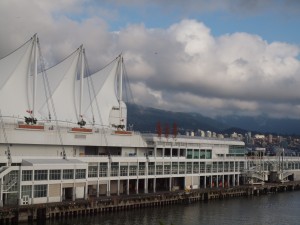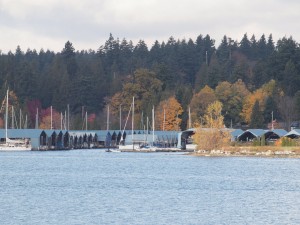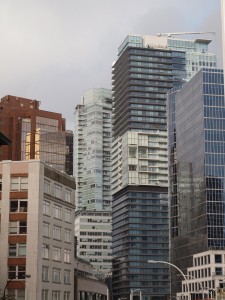
Canada Place, Vancouver’s fabulous convention center is in walking distance from some of the most historic neighborhoods in Vancouver.
There is a lot of talk about density and walkability in these new “green” times. Christopher Leinberger’s Op-Ed in the NY Times last week is getting a lot of play as is Edward Glaeser’s article in The Atlantic where he proclaims all dense all the time. Edward Glaeser argues that urban development should be less restrained by policy; specifically, that redevelopment of low-density urban areas is necessary to supplying housing at pace with demand enough to keep housing prices affordable in the cities where people most want to live. (from Julia Levitt’s Atlantic blog) I am no smart growth specialist and barely understand what makes good smart growth policy. But I am an architect who loves buildings and the places created by multiple buildings (cities). I can appreciate the importance density plays in cities like my beloved NY and recently-visited Vancouver – importance from an aesthetic point, as well as importance from a sustainable point. But I don’t think making every place a city like Dubai or even midtown Manhattan is what’s good for our souls. It may from an intellectual viewpoint be good for the planet (maybe) but layering our density, our styles and the age of our buildings is what makes our lives and this planet interesting. It’s up to us to figure out the balance.
Leaky Condos
Last month I gave two presentations about sustainability and preservation at events sponsored by the Vancouver Heritage Foundation. At one of them, a local mechanical engineer was surprised to hear that the President Lincoln’s Cottage Visitor Education Center in Washington, DC was able to meet and surpass ASHRAE code requirements and get LEED credits by restoring the original wood windows. In Vancouver, much of the code is now influenced by the “leaky condos law.” Many of the recent condominium buildings that Vancouver is known for have been suffering from massive water infiltration. New building techniques were used where the buildings were sealed so well that no air was allowed into the walls. As usual, of course, water was sucked into the walls, did not have any where to go and couldn’t evaporate, and started to rot the wood frame construction. In order to repair the problem, the walls have to be opened up, the rotten wood replaced and the building reclad. Wood windows have gotten a bad rap in Vancouver from no fault of their own.
Walking to the Waterfront
Vancouver’s waterfront is lined with many of the same condos that are known for their leaking. It is also one of the most accessible waterfronts of any major city and a great place to take a break from the downtown density. Density is better when you can step away from it for a little bit. Central Park is called the lungs of Manhattan, and although Vancouver has its own park in Stanley Park, I find the waterfront there more readily accessible. In Manhattan, I walk to Central Park. In Vancouver, I walk to the waterfront. And take a deep breath.

Walking along Vancouver’s waterfront with Stanley Park to the north and skyscrapers to the south. The diversity and layering of density makes it a glorious place.
Density – Is Building on Top of Our Heritage the Right Thing To Do?
In my last blog I discussed the questionable approach to saving a façade in order to add more floors and increase the density in a heritage area. Foster + Partners also added a skyscraper to the Hearst building (a lovely art deco building in the heart of midtown Manhattan). Another mistake in the name of density. I lived for ten years in a 6-story high apartment complex in Manhattan (City & Suburban), which is one of the most significant apartment building designs in the history of urban apartment buildings. Built for the working class poor in the early 1900s, they were the first apartment buildings with windows in every room, private bathrooms and cross ventilation. The story around landmarking this complex is legendary in NYC. The owner, a developer, first tried to tear them down, then tried to build on top of them. Finally, he gave up, sold the complex and 20 years later it remains one of the nicest places to live on the Upper East Side – a park to the south and the East River to the east, made it a glorious place to take a break from Manhattan’s density, which I loved to visit and work in, but when it came to living, the low-rise buildings were where I preferred to be. I, for one, am glad that New York City’s planning policy worked and some misplaced density desires did not lead to the demolition of City & Suburban Homes. And hopefully they never will.
And if you’d like to “subscribe” or follow this blog, True Green Cities, please sign up through the “Subscribe” button at the bottom left of this page. You’ll receive a daily recap when new blogs are posted.

